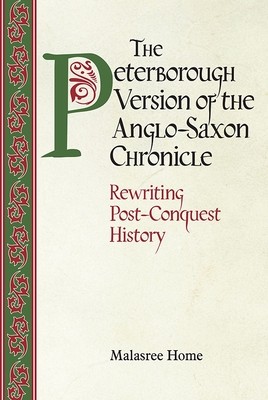
- We will send in 10–14 business days.
- Author: Malasree Home
- Publisher: Boydell Press
- Year: 2015
- Pages: 196
- ISBN-10: 1783270012
- ISBN-13: 9781783270019
- Format: 15.6 x 23.4 x 1.3 cm, hardcover
- Language: English
- SAVE -10% with code: EXTRA
The Peterborough Version of the Anglo-Saxon Chronicle (e-book) (used book) | bookbook.eu
Reviews
Description
An examination of the linguistic and cultural construction of one of the texts of the Anglo-Saxon Chronicle.
In the twelfth century, a version of the Anglo-Saxon Chronicle was rewritten at Peterborough Abbey, welding local history into an established framework of national events. This text has usually been regarded as an exception, a vernacular Chronicle written in a period dominated by Latin histories. This study, however, breaks new ground by considering the Peterborough Chronicle as much more than just an example of the accidental longevity of the Chronicle tradition. Close analysis reveals unique interpretations of events, and a very strong sense of communal identity, suggesting that the construction of this text was not a marginal activity, but one essential to the articulation of the abbey's image. This text also participates in a vibrant post-Conquest textual culture, in particular at Canterbury, including the writing of the bilingual F version of the Chronicle; its symbiotic relationship witha wider corpus of Latin historiography thus indicates the presence of shared sources. The incorporation of alternative generic types in the text also suggests the presence of formal hybridity, a further testament to a fluid and adaptable textual culture. Dr Malasree Home teaches at Newcastle University.EXTRA 10 % discount with code: EXTRA
The promotion ends in 20d.05:54:00
The discount code is valid when purchasing from 10 €. Discounts do not stack.
- Author: Malasree Home
- Publisher: Boydell Press
- Year: 2015
- Pages: 196
- ISBN-10: 1783270012
- ISBN-13: 9781783270019
- Format: 15.6 x 23.4 x 1.3 cm, hardcover
- Language: English English
An examination of the linguistic and cultural construction of one of the texts of the Anglo-Saxon Chronicle.
In the twelfth century, a version of the Anglo-Saxon Chronicle was rewritten at Peterborough Abbey, welding local history into an established framework of national events. This text has usually been regarded as an exception, a vernacular Chronicle written in a period dominated by Latin histories. This study, however, breaks new ground by considering the Peterborough Chronicle as much more than just an example of the accidental longevity of the Chronicle tradition. Close analysis reveals unique interpretations of events, and a very strong sense of communal identity, suggesting that the construction of this text was not a marginal activity, but one essential to the articulation of the abbey's image. This text also participates in a vibrant post-Conquest textual culture, in particular at Canterbury, including the writing of the bilingual F version of the Chronicle; its symbiotic relationship witha wider corpus of Latin historiography thus indicates the presence of shared sources. The incorporation of alternative generic types in the text also suggests the presence of formal hybridity, a further testament to a fluid and adaptable textual culture. Dr Malasree Home teaches at Newcastle University.

Reviews